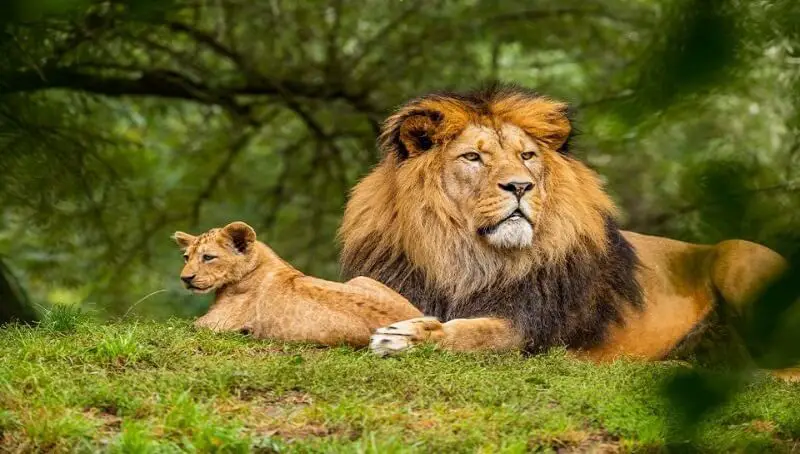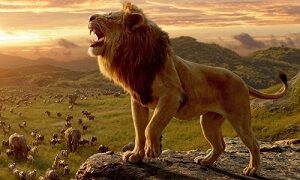
Why Hasn’t Your Dog Pooped For a While
September 14, 2022
Why is Your Dog Breathing Fast but Not Panting?
September 14, 2022
After the polar bear, the brown bear, and the tiger, the lion is one of the largest terrestrial predators. The lion is known as the “King of the jungle” or “King of the animals”.
The lion is by far one of the most famous animals in the world. Mistakenly nicknamed “King of the jungle,” the lion is one of the most powerful carnivores on Earth. Why is it wrong to say “The Lion, King of the jungle”?
The lion, Panthera Leo, also known as the king of animals, is part of the order of Carnivora, the Felidae family. Although until about 10.000 years ago the magnificent lion was, after man, the most widespread large terrestrial mammal, today the Asian lion is endangered and the African lion is declared vulnerable.
Lions are a symbol that often appears in the heraldry of royal families and cavalry. They even appear in Chinese art, although they never lived there.
No other animal has received more attention in art and literature. In the Bible, it is mentioned 130 times. In the art of the stone age, especially in cave paintings, drawings representing lions are frequently found.
Lions are wild mammals classified under the Felidae family of Panthera Genus, like the other large cats. They live in sub-Saharan Africa and some parts of Eurasia. Lions are generally carnivores that hunt both during night and day, and eat mostly ungulates as their main meal. They also eat zebras, elephants and rhinos, giraffes, and other meals when the opportunity presents itself.
The Lion got the name “King of the jungle” because of its appearance, cruel strength and power, and its unique social structure of pride. An average lion has a lifespan of 10 to 14 years but can live up to 20 years in monitored captivity.
What is a Jungle?
The jungle is a dense tropical or subtropical forest, hard to cross, with numerous bushes and lianas, often located in marshy regions. The largest jungles in the world are in equatorial Africa from Cameroon to the Democratic Republic of the Congo, in South and South East Asia from Myanmar to Indonesia and Papua New Guinea, and the Amazon Forest.
Although known as the “king of the jungle,” the lion is an animal that lives on open plains and can be found throughout Africa and not in the jungle. Even the producers of the animated film “The Lion King” were tempted to call the film “King of the jungle”, but they changed their minds when they realized that lions live in savannahs rather than in the jungle.
The Cultural Significance of Lion
The general expression of the lion in almost all cultures of the world is that of a popular symbol of royalty and steadiness, as well as a symbol of bravery. The representation of lions in human activities has been a thing since ancient times:
- the Nemean lion of ancient Greece and Rome;
- ivory sculpture with a lioness in the writings of southwestern Germany;
- the lion emblem on the decorative panel of the Persian Empire;
- the lion venerations of ancient Egypt;
- the emblem of the biblical lion in the Kingdom of Judah;
- the lion of ancient Mesopotamia as a symbol of the king;
- the Asian lion of the SynHalic and Chinese art;
- Narasimha in the texts of Hinduism.
In Africa, use can range from a symbol of power and royalty in West Africa to a symbol of laziness in other Eastern African traditions. Lions are often represented in artistic sculptures, on the coat of arms, and on official logos of countries such as Kenya.
Why Are Lions Called the King of The Jungle?
Since immemorial time, the lion has been considered the king of animals.
You might also like my articles on:
It may seem that the lion is recognized as king for his courage and dexterity. The lion is neither the most agile nor the fastest animal. But, on the other hand, it has other features that favorably distinguish it from other animals and give it the right to be called the King of animals. These include:
- unshakable self-confidence;
- majestic walk and posture;
- a chic mane that looks like a crown;
- the structure of the family, in which the male controls it closely.
The family rules are so clear in the pride of the lion, like in no other animal family.
 The lion is the head of the family and protects and takes care of its females and cubs. However, it is the females who, as a rule, hunt the prey, while the father-lion gets to eat first. While eating, no one has the right to touch the food until the father lion had enough.
The lion is the head of the family and protects and takes care of its females and cubs. However, it is the females who, as a rule, hunt the prey, while the father-lion gets to eat first. While eating, no one has the right to touch the food until the father lion had enough.
The growth of the young generation is carried out by females. The king of the animals can only play with the cubs.
The power of the lion is surrounded by legends because it really looks royal. Its incomparable mane of dark gold or black-brown gives it the greatness of a monarch, and the roar of the lion is no less impressive than its appearance. On a quiet night, the lion’s roar inspires amazement in all who hear it, even at a distance of eight kilometers.
The lion is a huge predator with a strong, flexible, agile, and muscular body, that runs well. This large predator cat has a well-developed neck and front paws with which it catches and holds its prey. The lion’s jaws are strong, with huge fangs and it can even hold animals as big as gnus. The tongue is rough and covered with tubers in the form of sharp tips, which help it catch and tear pieces of meat, literally tearing apart the prey. Lions also prey on large animals: zebras, gazels, and gnus, and do not despise theft, taking prey from other predators like hyenas.
The male lion is much larger than the female and 50 percent heavier in weight, but also easily recognizable by its massive mane.
Where do Lions live?
Africa
In Africa, lions live in the sub-Saharan region, with the exception of the equatorial rainforest and heavily populated regions along the southern coast of the western portion of the continent.
Lions are known to thrive, usually in savanna pastures, with scattered acacia trees, where they camouflage well with their surroundings. However, in southwestern Africa, there are desert-adapted lions that have evolved to withstand the harsh environment of the Namib desert in Namibia.
The majority of African wild lions live in East African countries such as Kenya and Tanzania, as well as in South African countries such as South Africa, Botswana, Zimbabwe, and Zambia.
Eurasia
Previously, lions were much more prevalent in Eurasia, especially in southern Eurasia, from Greece to India. But, due to the growing human population and interference, species have been reduced and are at risk of extinction.
The surviving lion of Eurasia lives inside and around the Gir Forest National Park in northwestern India. About 500 lions live in the 545.1762 square mile sanctuary area of Gujarat, which covers most of the forest.
The habitat of the Indian lion is a mixture of dry savanna forest and deciduous dry forest.
Population and Conservation
Estimates show that the lion population in Africa varies between 16,500 and 47,000, which is a worrying decline compared to 100,000 in 1990. Most lions now live in East and South Africa, and their numbers are falling rapidly. The number of mature lions in West Africa varies between 850 and 1,160. Another surviving population is in northwest Africa.
Both African and Eurasian lions are under conservation in national parks and hunting reserves created for the conservation of declining species. However, some lions in Africa are occasionally met in residential areas. Human diseases and interferences have proven to be the major challenges in conservation efforts.
Although the lion is called the king of the jungle, it actually lives in open fields, in almost all regions of Africa and in northwest India.
